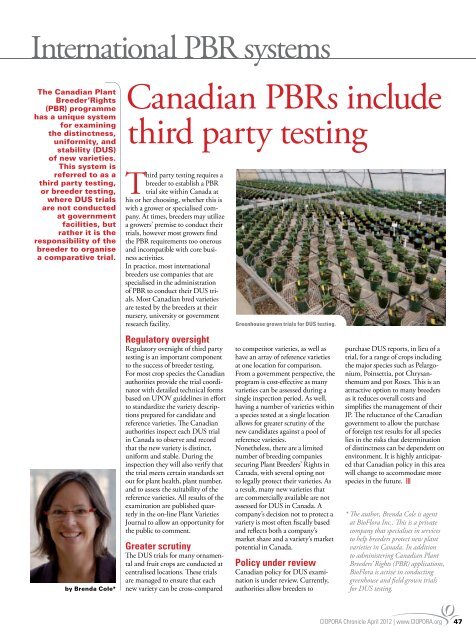2012 CIOPORA Chronicle
CIOPORA annual magazine on Intellectual Property protection for plant innovations 2012. The magazine was produced in cooperation with FloraCulture International. Read in the 2012 CIOPORA Chronicle edition: - Plant Patents in the United States after the America Invents Act - U.S. plant patents compared to UPOV PBR system - Does Belgian patent law need a breeder’s exemption? - How much open access can breeders afford? - IPP and PBR in Chile - IP protection for plant innovations in Canada and much more...
CIOPORA annual magazine on Intellectual Property protection for plant innovations 2012. The magazine was produced in cooperation with FloraCulture International.
Read in the 2012 CIOPORA Chronicle edition:
- Plant Patents in the United States after the America Invents Act
- U.S. plant patents compared to UPOV PBR system
- Does Belgian patent law need a breeder’s exemption?
- How much open access can breeders afford?
- IPP and PBR in Chile
- IP protection for plant innovations in Canada
and much more...
You also want an ePaper? Increase the reach of your titles
YUMPU automatically turns print PDFs into web optimized ePapers that Google loves.
International PBR systems<br />
The Canadian Plant<br />
Breeder’Rights<br />
(PBR) programme<br />
has a unique system<br />
for examining<br />
the distinctness,<br />
uniformity, and<br />
stability (DUS)<br />
of new varieties.<br />
This system is<br />
referred to as a<br />
third party testing,<br />
or breeder testing,<br />
where DUS trials<br />
are not conducted<br />
at government<br />
facilities, but<br />
rather it is the<br />
responsibility of the<br />
breeder to organise<br />
a comparative trial.<br />
by Brenda Cole*<br />
Canadian PBRs include<br />
third party testing<br />
Third party testing requires a<br />
breeder to establish a PBR<br />
trial site within Canada at<br />
his or her choosing, whether this is<br />
with a grower or specialised company.<br />
At times, breeders may utilize<br />
a growers’ premise to conduct their<br />
trials, however most growers find<br />
the PBR requirements too onerous<br />
and incompatible with core business<br />
activities.<br />
In practice, most international<br />
breeders use companies that are<br />
specialised in the administration<br />
of PBR to conduct their DUS trials.<br />
Most Canadian bred varieties<br />
are tested by the breeders at their<br />
nursery, university or government<br />
research facility.<br />
Regulatory oversight<br />
Regulatory oversight of third party<br />
testing is an important component<br />
to the success of breeder testing.<br />
For most crop species the Canadian<br />
authorities provide the trial coordinator<br />
with detailed technical forms<br />
based on UPOV guidelines in effort<br />
to standardize the variety descriptions<br />
prepared for candidate and<br />
reference varieties. The Canadian<br />
authorities inspect each DUS trial<br />
in Canada to observe and record<br />
that the new variety is distinct,<br />
uniform and stable. During the<br />
inspection they will also verify that<br />
the trial meets certain standards set<br />
out for plant health, plant number,<br />
and to assess the suitability of the<br />
reference varieties. All results of the<br />
examination are published quarterly<br />
in the on-line Plant Varieties<br />
Journal to allow an opportunity for<br />
the public to comment.<br />
Greater scrutiny<br />
The DUS trials for many ornamental<br />
and fruit crops are conducted at<br />
centralised locations. These trials<br />
are managed to ensure that each<br />
new variety can be cross-compared<br />
Greenhouse grown trials for DUS testing.<br />
to competitor varieties, as well as<br />
have an array of reference varieties<br />
at one location for comparison.<br />
From a government perspective, the<br />
program is cost-effective as many<br />
varieties can be assessed during a<br />
single inspection period. As well,<br />
having a number of varieties within<br />
a species tested at a single location<br />
allows for greater scrutiny of the<br />
new candidates against a pool of<br />
reference varieties.<br />
Nonetheless, there are a limited<br />
number of breeding companies<br />
securing Plant Breeders’ Rights in<br />
Canada, with several opting not<br />
to legally protect their varieties. As<br />
a result, many new varieties that<br />
are commercially available are not<br />
assessed for DUS in Canada. A<br />
company’s decision not to protect a<br />
variety is most often fiscally based<br />
and reflects both a company’s<br />
market share and a variety’s market<br />
potential in Canada.<br />
Policy under review<br />
Canadian policy for DUS examination<br />
is under review. Currently,<br />
authorities allow breeders to<br />
purchase DUS reports, in lieu of a<br />
trial, for a range of crops including<br />
the major species such as Pelargonium,<br />
Poinsettia, pot Chrysanthemum<br />
and pot Roses. This is an<br />
attractive option to many breeders<br />
as it reduces overall costs and<br />
simplifies the management of their<br />
IP. The reluctance of the Canadian<br />
government to allow the purchase<br />
of foreign test results for all species<br />
lies in the risks that determination<br />
of distinctness can be dependent on<br />
environment. It is highly anticipated<br />
that Canadian policy in this area<br />
will change to accommodate more<br />
species in the future. |||<br />
* The author, Brenda Cole is agent<br />
at BioFlora Inc.. This is a private<br />
company that specialises in services<br />
to help breeders protect new plant<br />
varieties in Canada. In addition<br />
to administering Canadian Plant<br />
Breeders’ Rights (PBR) applications,<br />
BioFlora is active in conducting<br />
greenhouse and field grown trials<br />
for DUS testing.<br />
<strong>CIOPORA</strong> <strong>Chronicle</strong> April <strong>2012</strong> | www.<strong>CIOPORA</strong>.org 47









